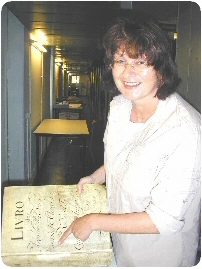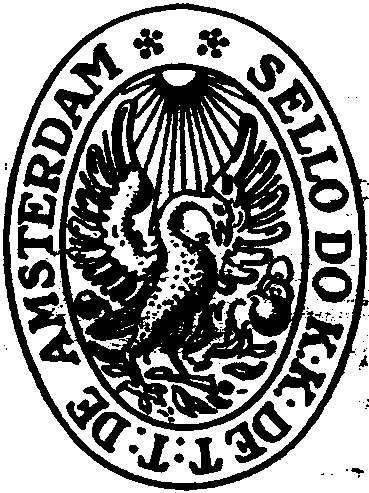Jewish cemetery Beth Haim at Ouderkerk aan de Amstel
Joint project of the Portuguese Israelite Community and Akevoth.
This introduction has been written by Mrs. Lydia Hagoort,
author of the book "Het Beth Haim in Ouderkerk aan de Amstel"
ISBN nummer 90-6550-861-9
Published by Verloren in Hilversum

The first Sephardic Jews came to Amsterdam towards the end of the 16th century. In this town they enjoyed the fundamental freedom they were lacking in the rest of Europe.
In 1612 there was still no permission to build a synagogue, though services were held with the knowledge of the municipal council in synagogues in private homes.
Twice, in 1606 and 1608, Portuguese-Jewish merchants requested permission from the municipal council to buy a piece of land to bury their dead, but this was rejected in both instances.
In the spring of 1614 they bought a small piece of land in Ouderkerk, this time through intermediaries.
The purpose of the deal was not disclosed and no consent was asked for.
So the municipal council of Amsterdam was officially not aware that it concerned a Jewish cemetery.
Beth Haim was inaugurated with the burial of Joseph, the son of David Senior.
The inhabitants of the village showed compassion with the death of the child, but quickly the mood changed.
They protested with the authorities against the burial of Jews in their village.
The `Staten van Holland` (the Governors of the Province of Holland ) dismissed the complaints and gave the Portuguese Jews official consent to bury their dead in May 1614. The plot was completely redone and in 1616 came into renewed use officially.
Till that year, as from 1607, the Sephardim had buried their dead in Groet near Alkmaar. Those interred in Groet, could be reburied at Ouderkerk, upon the request of their relatives. In 1626 it was decided to transfer the remains of the other deceased to Ouderkerk, as a precautionary measure after the robbing of some gravestones. At least 52 persons from Groet were reinterred in Ouderkerk.
At the outset, also Ashkenazi or “Hoogduitse” Jews used the cemetery in Ouderkerk. Till spring 1642, when the cemetery of Muiderberg was consecrated, at least 42 Ashkenazi Jews, among them 45 children, were buried here.
Besides Ashkenazi and Sephardic Jews also a group of black Jews, mostly freed slaves, has been buried in Ouderkerk. In total at least 40, up till 1716.
After that the colour of the skin of the deceased was not mentioned anymore in the registers.
Those graves normally did not have a stone, but there is one exception.
In the summer of 2002 a (simple) stone was uncovered, under the direction of a rabbi, on the most ancient part of the cemetery, belonging to Elieser, the black servant of Paulo de Pina alias Rohjel Jesurun. Elieser was buried in 1629; the rabbi could trace the stone relying on the “cartons” of the famous researcher David Henriques de Castro Mzn.
It is the only stone of a liberated slave and black Jew discovered in Western Europe up till now.
Altogether about 30,000 people lay buried in Ouderkerk aan de Amstel.
The piece of land was at the time of purchase of limited extent: - one third of a “morgen”, meaning 0.28 hectare. On this small piece the impressing tombstones of dr. Eliau Montalto, Don Samuel Palache and the hahamim Izac Uziel and Joseph Pardo are still present. In 1663, 1671, 1690, and 1691 the parnassim (the governors of the Portuguese community) bought additional pieces of land.
After these acquisitions, the total area was about 28 `morgen`, that is 24 hectare. Most of it was leased out. At the end of the 20th century the remaining space suitable for burial, was becoming too small.
The problem was solved by heightening a field with mostly graves dating back to the eighteenth century. On this field, the use of which started in 1924, chief rabbi Izack de Juda Palache was buried in December 1925. His tomb is a creation of the sculptor Joseph Mendes da Costa.
The “Stone Room” (stenen kamer) dating from the Middle Ages, that stood in the center of the plot, served up till 1643 as Rodeamentoshuis, the House of Processions. In that year a new impressive house was built, near the gate/entrance on the side leading to the village. In 1705 a second building was erected, at the waterside, the Bullewijk. This Rodeamentoshuis is still in use, the other house functioned as accomodation for receptions and the dwelling of the cemetery’s keeper. A storm in the autumn of 1836 destroyed this house.
The parnassim ordered the construction of an entirely new dwelling.
In 1838 it was put to use. This house still functions as premises of the keeper of the cemetery and was recently renovated.
Almost every visitor to the Beth Haim in Ouderkerk is impressed by this very special cemetery. Its location alongside the water, and in the center of the village, the sculptured tombstones in the grass among the elms and the willows and the characteristic architectural style of the Rodeamentoshuis contribute to this. It is dominated by a pleasant calm and ease; in summer the birds sing and the expert sees rare flowers, mosses, plants, grasses and butterflies: no use is made of articificial pesticides. When walking through the grass and alongside the graves, the visitor is overcome by a feeling of eternity and respect. The grandezza on the old field, where the monumental tombs are situated, is still touchable.
But also on the heightened field, where Haham Palache is buried, and on the spot of the 19th century graves, with its many monuments, one lives through history in a very direct manner.
Beth Haim has been added to the list of `rijksmonumenten` (Monuments are now officially protected by law), in 1963, two years later the plots attached to it were sold. The Rodeamentohuis has been restored to its original state of the 18th century in 1966.
The “Association for maintenance and upkeep of historical Jewish Cemeteries in the Netherlands` [“Stichting tot onderhoud en instandhouding van historische Joodse begraafplaatsen in Nederland”] was founded in 1963 on the recommendation of the National Administration for Preservation of Monuments [Rijksdienst voor Monumentenzorg]. The association looks i.a. after the registration of the graves, organizes tours and lectures and answers the many requests for information from inside the country and abroad. In 1997 the David Henriques de Castrofund was founded, for the acquisition of funds for the maintenace and the restauration of the cemetery.
The town of Amsterdam, the State and the Provincial Authorities contributed money for the restauration.
The restauration, started in 1999 and also sponsored by many private donors, will take many years to complete.
